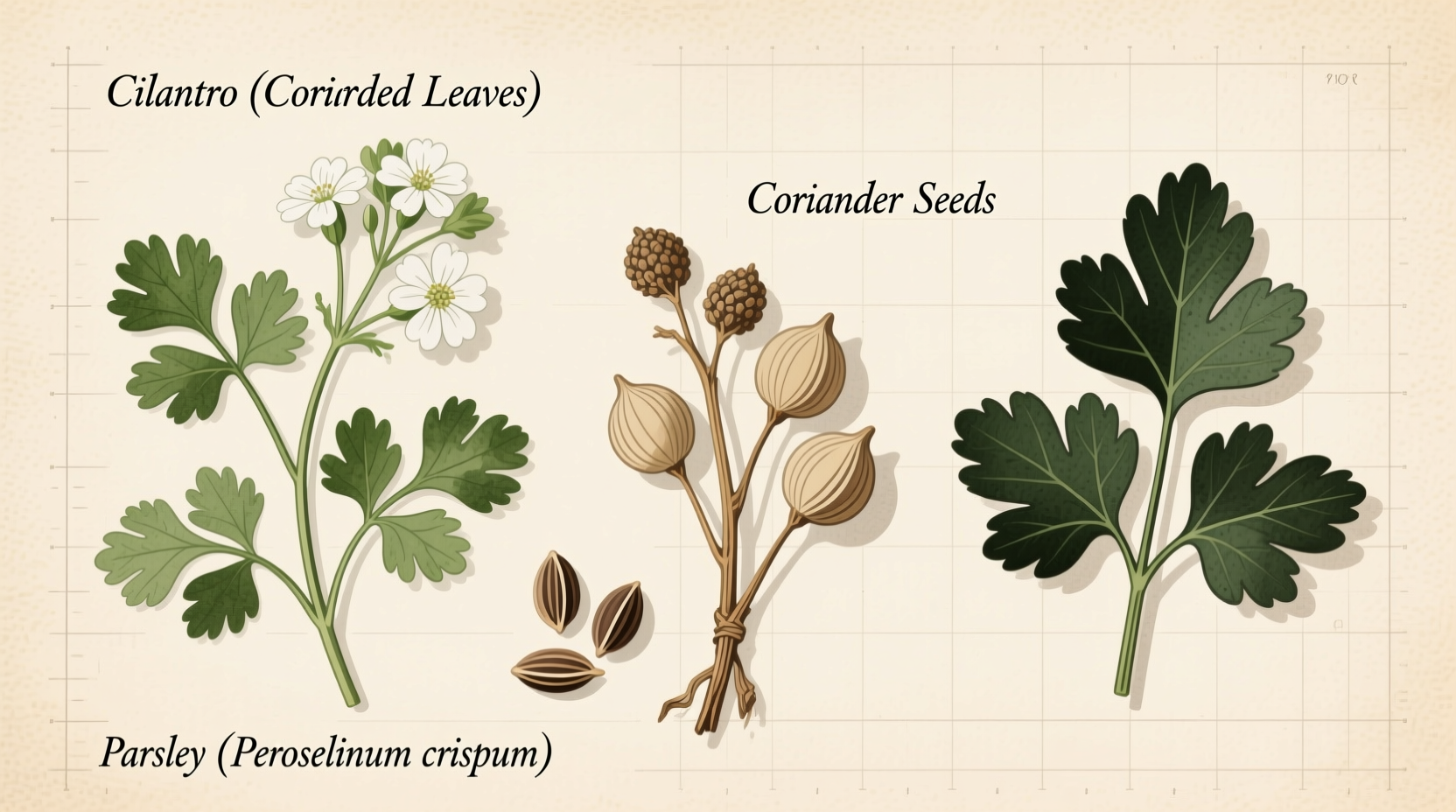Why Everyone Gets Confused: The Cilantro/Coriander Naming Puzzle
When you're standing in the grocery store holding two different packages labeled "cilantro" and "coriander," it's completely understandable to be confused. The truth is simple: they're from the same plant. The naming difference depends entirely on which part you're using and where you live.
In the United States and Latin America, we call the fresh leaves "cilantro" and the dried seeds "coriander." But in the UK, Australia, and most Commonwealth countries, the fresh leaves are called "coriander" while the seeds are "coriander seeds." This regional language difference causes endless confusion for home cooks and professional chefs alike.
| Term | Refers To | Common Regions | Botanical Name |
|---|---|---|---|
| Cilantro | Fresh leaves and stems | United States, Latin America | Coriandrum sativum (leaf) |
| Coriander (leaves) | Fresh leaves and stems | UK, Australia, Europe | Coriandrum sativum (leaf) |
| Coriander (seeds) | Dried seeds | Worldwide | Coriandrum sativum (seed) |
| Parsley | Fresh leaves | Worldwide | Petroselinum crispum |
Spot Them at a Glance: Visual Identification Guide
When recipes call for one but your market has another, knowing how to visually distinguish these herbs prevents culinary disasters. Here's what to look for:

Cilantro Identification
- Leaves: Delicate, lacy, deeply serrated edges with rounded tips
- Color: Vibrant medium green
- Stems: Thin, edible, and flavorful (don't discard!)
- Scent: Bright, citrusy aroma with a distinctive punch
Parsley Identification
- Leaves: Flat or curly with pointed tips (Italian parsley is flat-leaf)
- Color: Deeper, darker green than cilantro
- Stems: Thicker, more fibrous, usually discarded before serving
- Scent: Mild, grassy, slightly peppery aroma
Flavor Chemistry: Why They Taste So Different
The dramatic flavor difference between these herbs comes down to their chemical composition. Cilantro contains aldehydes that give it that distinctive citrusy-coriander flavor, while parsley contains different compounds that create its milder profile.
Interestingly, about 21% of people have a genetic variation that makes cilantro taste like soap to them, according to research published in the journal Chemical Senses. This genetic factor explains why some people love cilantro while others can't stand it.
Culinary Applications: When to Use Which Herb
Understanding where each herb shines prevents recipe failures and elevates your cooking:
Cilantro: The Fresh Finisher
- Best for: Salsas, guacamole, Thai curries, Vietnamese pho, Indian chutneys
- When to add: Always at the end of cooking or as garnish (heat destroys its delicate flavor)
- Pro tip: The stems contain concentrated flavor - chop finely and use in marinades
Coriander Seeds: The Warm Base Note
- Best for: Curries, pickling spices, baked goods, sausage blends, Middle Eastern spice mixes
- When to use: Toast whole seeds before grinding for maximum flavor release
- Pro tip: Coriander seeds pair exceptionally well with cumin and turmeric
Parsley: The Versatile Workhorse
- Best for: Gremolata, tabbouleh, chimichurri, finishing sauces, garnishing roasted meats
- When to add: Can withstand moderate cooking (unlike cilantro)
- Pro tip: Flat-leaf (Italian) parsley has more flavor than curly parsley
Substitution Guide: When You're Out of One Herb
Running to the store isn't always practical. Here's when substitutions work (and when they'll ruin your dish):
Acceptable Substitutions
- Cilantro → Parsley + lime zest: For garnishes where appearance matters (adds back some citrus notes)
- Parsley → Cilantro stems: In cooked dishes where fresh cilantro leaves would be too strong
- Coriander seeds → Cumin (sparingly): In spice blends where warm notes are needed
Substitutions to Avoid
- Using parsley instead of cilantro in salsa: You'll lose the essential citrus note that balances tomatoes and chilies
- Using cilantro instead of parsley in tabbouleh: The strong cilantro flavor overwhelms the delicate bulgur wheat
- Using coriander seeds where fresh cilantro is called for: They're completely different ingredients with different flavor profiles
Storage Secrets: Keeping Your Herbs Fresh Longer
Nothing wastes money like wilted herbs. Follow these science-backed storage methods:
- Cilantro: Trim stems, place in jar with 1 inch of water, cover loosely with plastic bag, refrigerate. Change water every 2 days. Lasts 10-14 days.
- Parsley: Same method as cilantro but lasts even longer (up to 3 weeks). The thicker stems are more resilient.
- Coriander seeds: Store whole seeds in airtight container away from light. They retain flavor for 1 year (ground coriander loses potency in 3-6 months).
Common Mistakes Even Experienced Cooks Make
Avoid these pitfalls that undermine your dishes:
- Mistake: Washing herbs and not drying properly before storage Solution: Use salad spinner then wrap in paper towels before refrigerating
- Mistake: Using only cilantro leaves and discarding stems Solution: Finely chop tender stems - they contain concentrated flavor
- Mistake: Adding fresh cilantro early in cooking Solution: Always add at the very end to preserve delicate flavor compounds
- Mistake: Confusing dried cilantro (which loses most flavor) with fresh Solution: Never substitute dried cilantro for fresh - they're not equivalent
Historical Context: How These Herbs Traveled the World
Coriander (both leaves and seeds) has been used for over 5,000 years, with seeds found in ancient Egyptian tombs. The Romans spread coriander throughout Europe, where it became known as "coriandrum" in Latin. When Spanish explorers brought it to the Americas, indigenous populations adopted it quickly into their cuisines, calling the fresh leaves "cilantro" from the Spanish word "coriandrum."
Parsley's history differs significantly - it was originally used as a medicinal herb in ancient Greece and Rome before becoming a culinary staple. Unlike cilantro/coriander which traveled along spice routes, parsley spread more slowly through Europe and wasn't widely used in cooking until the Middle Ages.











 浙公网安备
33010002000092号
浙公网安备
33010002000092号 浙B2-20120091-4
浙B2-20120091-4